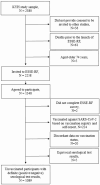Spectrum of COVID-19 cases in Arkhangelsk, Northwest Russia: Findings from a population-based study linking serosurvey, registry data, and self-reports of symptoms
- PMID: 39392813
- PMCID: PMC11469529
- DOI: 10.1371/journal.pone.0311287
Spectrum of COVID-19 cases in Arkhangelsk, Northwest Russia: Findings from a population-based study linking serosurvey, registry data, and self-reports of symptoms
Abstract
Introduction: The spectrum of COVID-19 manifestations makes it challenging to estimate the exact proportion of people who had the infection in a population, with the proportion of asymptomatic cases likely being underestimated. We aimed to assess and describe the spectrum of COVID-19 cases in a sample of adult population aged 40-74 years in Arkhangelsk, Northwest Russia, a year after the start of the pandemic.
Materials and methods: A population-based survey conducted between February 24, 2021 and June 30, 2021 with an unvaccinated sample aged 40-74 years (N = 1089) combined a serological survey data, national COVID-19 case registry, and self-reported data on COVID-19 experience and symptoms. Based on the agreement between these sources, we classified the study participants as non-infected and previously infected (asymptomatic, non-hospitalized and hospitalized symptomatic) cases, and compared these groups regarding demographics, lifestyle and health characteristics.
Results: After a year of the pandemic in Arkhangelsk, 59.7% 95% confidence intervals (CI) (56.7; 62.6) of the surveyed population had had COVID-19. Among those who had been infected, symptomatic cases comprised 47.1% 95% CI (43.2; 51.0), with 8.6% 95% CI (6.6; 11.1) of them having been hospitalized. Of the asymptomatic cases, 96.2% were not captured by the healthcare system. Older age was positively associated, while smoking showed a negative association with symptomatic COVID-19. Individuals older than 65 years, and those with poor self-rated health were more likely to be hospitalized.
Conclusion: More than half of the infected individuals were not captured by the healthcare-based registry, mainly those with asymptomatic infections. COVID-19 severity was positively associated with older age and poor self-rated health, and inversely associated with smoking. Combining different sources of surveillance data could reduce the number of unidentified asymptomatic cases and enhance surveillance for emerging infections.
Copyright: © 2024 Krieger et al. This is an open access article distributed under the terms of the Creative Commons Attribution License, which permits unrestricted use, distribution, and reproduction in any medium, provided the original author and source are credited.
Conflict of interest statement
the authors report there are no competing interests to declare
Figures




Similar articles
-
COVID-19: seroprevalence and adherence to preventive measures in Arkhangelsk, Northwest Russia.Infect Dis (Lond). 2023 May;55(5):316-327. doi: 10.1080/23744235.2023.2179660. Epub 2023 Mar 15. Infect Dis (Lond). 2023. PMID: 36919829
-
COVID-19 pandemic in Saint Petersburg, Russia: Combining population-based serological study and surveillance data.PLoS One. 2022 Jun 15;17(6):e0266945. doi: 10.1371/journal.pone.0266945. eCollection 2022. PLoS One. 2022. PMID: 35704649 Free PMC article.
-
Effectiveness and cost-effectiveness of four different strategies for SARS-CoV-2 surveillance in the general population (CoV-Surv Study): a structured summary of a study protocol for a cluster-randomised, two-factorial controlled trial.Trials. 2021 Jan 8;22(1):39. doi: 10.1186/s13063-020-04982-z. Trials. 2021. PMID: 33419461 Free PMC article.
-
Estimating the asymptomatic proportion of SARS-CoV-2 infection in the general population: Analysis of nationwide serosurvey data in the Netherlands.Eur J Epidemiol. 2021 Jul;36(7):735-739. doi: 10.1007/s10654-021-00768-y. Epub 2021 Jun 10. Eur J Epidemiol. 2021. PMID: 34114187 Free PMC article.
-
Universal screening for SARS-CoV-2 infection: a rapid review.Cochrane Database Syst Rev. 2020 Sep 15;9(9):CD013718. doi: 10.1002/14651858.CD013718. Cochrane Database Syst Rev. 2020. PMID: 33502003 Free PMC article.
References
MeSH terms
LinkOut - more resources
Full Text Sources
Medical

